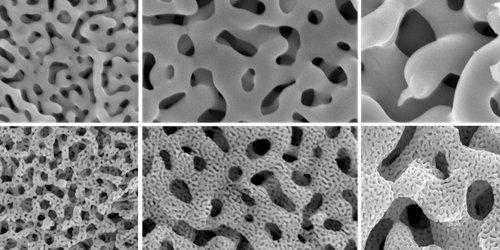Tailoring the Sizes of Pores in Nanoporous Gold
Conceivably, the performance of a catalyst such as palladium or ruthenium could be improved by fashioning the metal as a foam with pores of two sizes. But only if the size of the small pores is optimized to maximize the area exposed to reagents and the size of the larger ones, the flow of reagents and products. Ten years ago, researchers from Hamburg University of Technology, Germany, devised a recipe for making such a hierarchical structure out of an alloy of silver and gold. Now the same group has figured out how to tailor the process to make foamy structures “to order” [1].
The original recipe’s starting point is an alloy of 90% silver and 10% gold, and the first step requires dissolving the alloy in an electrolytic bath until its silver content has halved and the remains have a foamy structure resembling a sponge cake. The “cake” is then baked at a few hundred degrees Celsius, melting the metal and causing the sponge’s tiny cavities to close while opening larger cavities via a surface-tension-driven instability. A quenching step freezes the system, which still resembles a sponge cake but with larger cavities than before. Finally, the alloy is subjected to a second bout of corrosion that removes the remaining silver, creating an additional foamy structure, while leaving the larger cavities intact.
The group’s updated recipe includes the option to vary the voltage applied during electrolysis and the temperature applied during annealing. The researchers monitored the effect of both parameters on the system’s pore sizes using x-ray scattering methods. They found that they could tailor the distance between the centers of the small cavities to be 40–80 nm and that of the large cavities to be 100–400 nm. Not limited to gold, the team says that the recipe could be applied to other catalytic metals as well.
–Charles Day
Charles Day is a Senior Editor for Physics Magazine.
References
- L. Riedel et al., “Tailoring hierarchical nanoporous gold on dual length scales,” Phys. Rev. Mater. 7, 116001 (2023).




